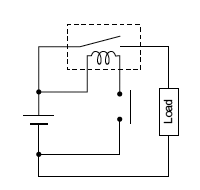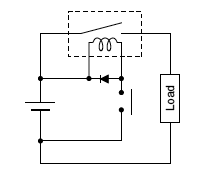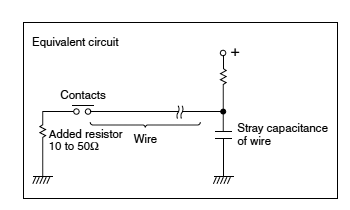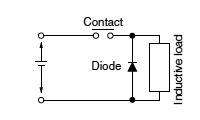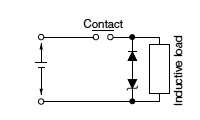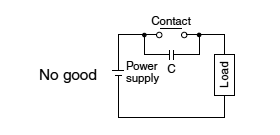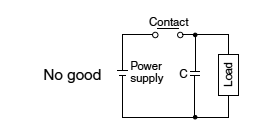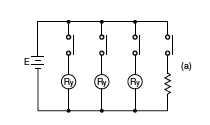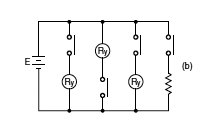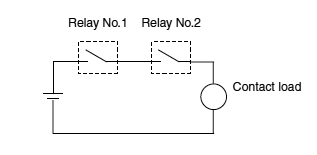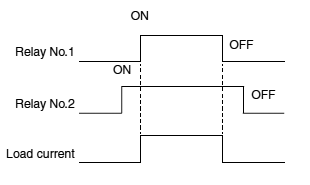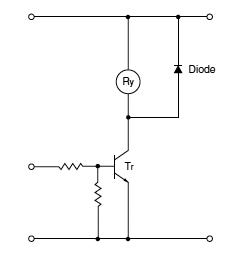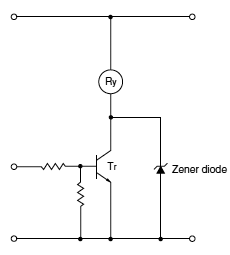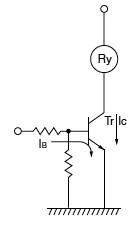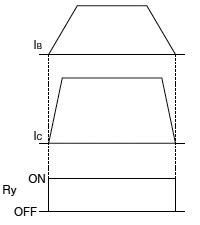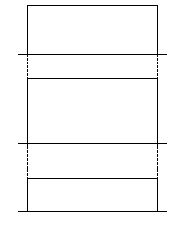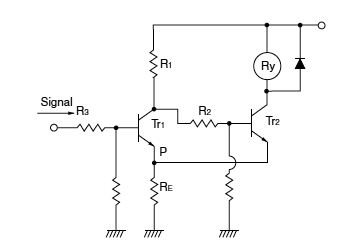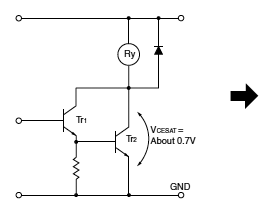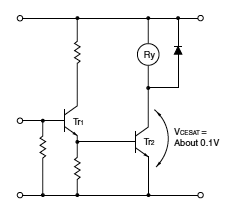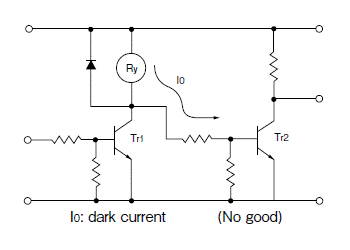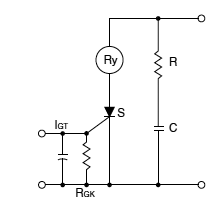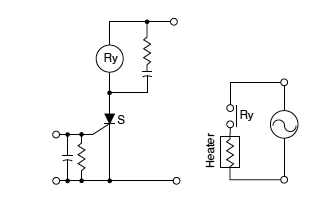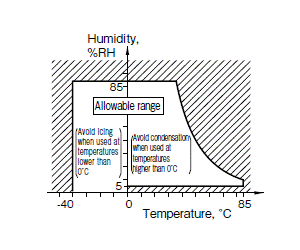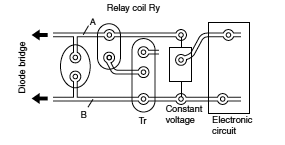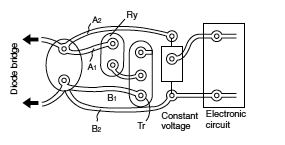2. Hole and Land diameter
The Hole and Land diameter are made with the hole slightly larger than the lead wire so that the component may be inserted easily. Also, when soldering, the solder will build up in an eyelet condition, increasing the mounting strength. The standard dimensions for the Hole diameter and Land are shown in the table below.
Standard dimensions for the Hole and Land diameter
(Unit: mm)
| Standard hole | Tolerance | Land diameter |
|---|
| 0.8 | ±0.1 | 2.0 to 3.0 |
| 1.0 |
| 1.2 | 3.5 to 4.5 |
| 1.6 |
(Remarks)
- The Hole diameter is made 0.2 to 0.5 mm larger than the lead diameter.
However, if the jet method (wave type, jet type) of soldering is used, solder may pass through to the component side. Therefore, it is more suitable to make the hole diameter equal to the lead diameter +0.2 mm. - The Land diameter should be 2 to 3 times the Hole diameter.
- Do not put more than 1 lead in one hole.
3. Expansion and shrinkage of copper-clad laminates
Because copper-clad laminates have a longitudinal and lateral direction, the manner of punching fabrication and layout must be observed with care. Expansion and shrinkage in the longitudinal direction due to heat is 1/15 to 1/2 of that in the lateral, and accordingly, after the punching fabrication, the distortion in the longitudinal direction will be 1/15 to 1/2 of that in the lateral direction. The mechanical strength in the longitudinal direction is 10 to 15% greater than that in the lateral direction.
Because of this difference between the longitudinal and lateral directions, when products having long configurations are to be fabricated, the lengthwise direction of the configuration should be made in the longitudinal direction, and PC boards having a connector section should be made with the connector along the longitudinal side. (The figure below)
Example: As shown in the drawing below, the 150 mm direction is taken in the longitudinal direction.
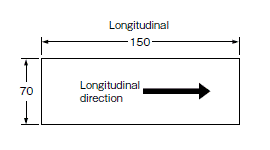
Also, as shown in the drawing below, when the pattern has a connector section, the direction is taken as shown by the arrow in the longitudinal direction.
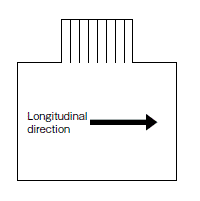
15. PC board mounting
1. Through-hole type
In keeping with making devices compact, it is becoming more common to solder the relay to a PC board along with the semiconductors instead of using the previous plug-in type in which relays were plugged into sockets.
With this style, loss of function may occur because of seepage into the relay of flux, which is applied to the PC board. Therefore, the following precautions are provided for soldering a relay onto a PC board. Please refer to them during installation in order to avoid problems.
The type of protective structure will determine suitability for automatic soldering or automatic cleaning. Therefore, please review the parts on construction and characteristics.
1. Mounting of Relay
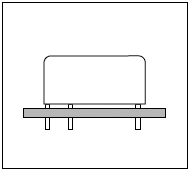
- Avoid bending the terminals to make the relay self-clinching. Relay performance cannot be guaranteed if the terminals are bent.
- Correctly make the PC board according to the given PC board pattern illustration.
- Tube packaging for automatic mounting is available depending on the type of relay. (Be sure that the relays don't rattle.) Interference may occur internally if the gripping force of the tab of the surface mounting machine is too great.
This could impair relay performance.
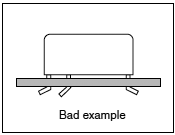
2. Flux Application

- Adjust the position of the PC board so that flux does not overflow onto the top of it. This must be observed especially for dust-cover type relays.
- Use rosin-based non-corrosive flux.
- If the PC board is pressed down into a flux-soaked sponge as shown below, the flux can easily penetrate a dust-cover type relay. Never use this method. Note that if the PC board is pressed down hard enough, flux may even penetrate a flux tight type relay.
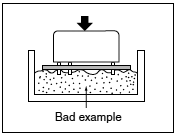
3. Preheating
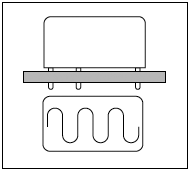
- Be sure to preheat before using automatic soldering. For dust-cover type relays and flux-resistant type relays, preheating acts to prevent the penetration of flux into the relay when soldering. Solderability also improves.
- Preheat according to the following conditions.
| Temperature | 100°C or less
(PC board solder surface) |
|---|
| Time | Within 2 minutes |
|---|
- Note that long exposure to high temperatures (e.g. due to a malfunctioning unit) may affect relay characteristics.
Note) CB and CM relays are not applicable. Please refer to individual product catalog.
4. Soldering
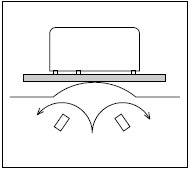
Automatic soldering
- Wave solder is the optimum method for soldering.
- Adjust the level of solder so that it does not overflow onto the top of the PC board.
- Unless otherwise specified, solder under the following conditions depending on the type of relay.
- Please take caution with multi-layer boards. Relay performance may degrade due to the high thermal capacity of these boards.
| Solder temperature | 260°C or less |
|---|
| Soldering time | Within 5 seconds |
|---|
Hand soldering
- Keep the tip of the soldering iron clean.
| Soldering iron | 30W to 60W |
|---|
| Iron tip temperature | 300°C |
|---|
| Soldering time | Within 3 seconds |
|---|
Note) CB and CM relays are not applicable. Please refer to individual product catalog.
5. Cooling
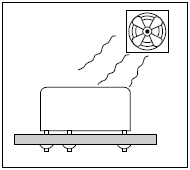
- Immediate air cooling is recommend to prevent deterioration of the relay and surrounding parts due of soldering heat.
- Avoid immersing the relay into cold liquid (such as cleaning solvent and coating material) immediately after soldering. Doing so may deteriorate the sealing performance.
6. Cleaning
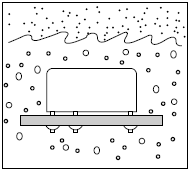
- Do not clean products that are not compatible with cleaning.
- For products that may be cleaned, use alcohol-based cleaning solvent. Use of other cleaning solvents (e.g. Trichlene, chloroethene, thinner, benzyl alcohol, gasoline) may damage the relay case.
- Avoid ultrasonic cleaning on relays. Use of ultrasonic cleaning may cause breaks in the coil or slight sticking of the contacts due to the ultrasonic energy.
- Please avoid glass shot cleaning. Glass powder may get inside the relay and cause malfunctions.
- Do not cut the terminals. When terminals are cut, breaking of coil wire and slight sticking of the contacts may occur due to vibration of the cutter.
7. Coating
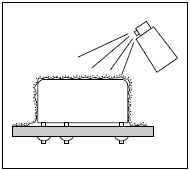
2. SMD type
To meet the market demand for downsizing to smaller, lighter, and thinner products, PC boards also need to proceed from insertion mounting to surface mounting technology.
To meet this need, we offer a line of surface mount relays. The following describes some cautions required for surface mount relay installation to prevent malfunction and incorrect operation.
*Please inquire our sales representative for or reflow soldering of through-hole terminal type.
1. Paste Soldering
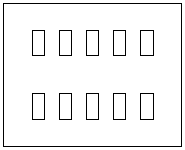
- Mounting pads on PC boards must be designed to absorb placement errors while taking account of solderability and insulation. Refer to the suggested mounting pad layout in the application data for the required relay product.
- Paste solder may be applied on the board with screen printing or dispenser techniques. For either method, the paste solder must be coated to appropriate thickness and shapes to achieve good solder wetting and adequate insulation.
Screen Printing
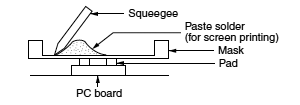
Solder Dispenser
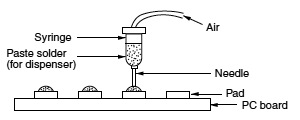
2. Relay mounting
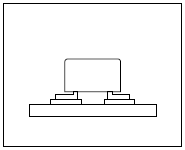
- A self-alignment effect is expected during soldering of small and lightweight (approx. 100 mg or less) components such as chip components but such effect cannot be expected for electro-mechanical components such as relays. Positional alignment of a relay and lands on a circuit board requires precise positioning on its soldering pads.
- Excessive pickup force exerted by a placement machine could cause internal damage, and performance of the relay cannot be warranted.
- Component taping compatible with automated placement is adopted for this product.
- Once the humidity controlled package is opened, relays should be used promptly. (For possible storage period after opening a package, please refer to the catalog for the product concerned. If products are not used within the possible storage period, they should be stored in a humidity-controlled desiccator or in a moisture-prevention bag with silica gel.)
3. Reflow
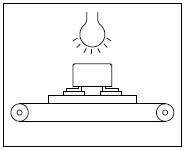
- Even when highly heat resistance surface mount type relays are used, depending on the product airtight implementation, reflow solder heating method, type of PC board and other factors, the outer casing and internal parts of the relay may reach extremely high temperatures and this may break airtightness. Devices should be thoroughly evaluated in actual operation.
<Example of recommended soldering condition for surface mount relays>
1. IRS profile
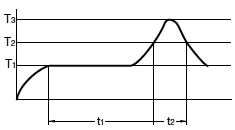
T1 = 150 to 180°C
T2 = 230°C or more
T3 = Less than 250°C
t1 = 60 to 120 sec.
t2 = Less than 30 sec.

Note) Temperature profile indicates the temperature of the soldered part (*1) of terminals on the surface of a circuit board. The exterior temperature of a relay may be extremely high depending on the component density on the board or the heating method of the reflow oven or circuit board type. Sufficient verification under actual processing conditions is required. Performance-guaranteed temperature varies by product. Please refer to the relevant product catalog.
<Others>
For other solder methods except for the above (such as hot air heating, hot plate heating, laser heating, pulse heating, etc.), please check for mounting and soldering condition before use.
It is recommended that the soldered pad be immediately cooled to prevent thermal damage to the relay and its associated components.
4. Cooling / Cleaning
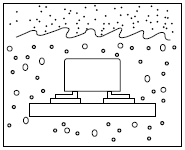
- In order to avoid deterioration of relays and other components caused by soldering heat, immediate air cooling is recommended.
- Avoid cleaning (ultrasonic cleaning, boiling cleaning, glass shot cleaning, etc) and coating in order to prevent negative impacts on relay characteristics.
16. Storage, transportation
1. Transportation
Relay's functional damage may occur if strong vibration, shock or heavy weight is applied to a relay during transportation of a device in which a relay is installed. Therefore, please pack them in a way, using shock-absorbing material, so that the allowable range for vibration and shock is not exceeded.
2. Storage
If the relay is stored for extended periods of time (including transportation period) at high temperatures or high humidity levels or in atmospheres with organic gas or sulfide gas, sulfide film or oxide film may be formed on surface of the contacts, which may cause contact instability, contact failure and functional failure. Please check the atmosphere in which the units are to be stored and transported.
17. Product handling
1. Tube packing
Some types of relays are supplied with tube packaging. If you remove some relays from the tube, be sure to slide a stop plug into one end of a tube to hold the remaining relays firmly and avoid rattling of relay inside the tube. Note that rattling may cause a damage on appearance and/or performance.
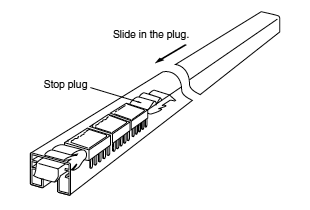
Do not use the relays if they were dropped or fallen down in a tube packing condition because there is a risk of characteristic failure.
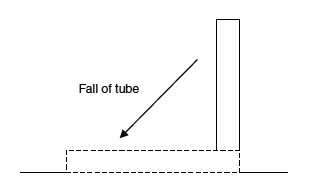
2. Cautions after relay mounting
If PC boards are processed after relays have been mounted on the board, it is possible that swarf or other foreign matter resulting from machining or other processes may get inside the relays and cause malfunctions or contact failure. Pay particular attention if using flux tight relays or relays with vent hole. In addition, take care to avoid vibrations and shocks during PC board processing that may affect the characteristics and structural integrity of the relay.
18. Reliability
1. What is Reliability?
1. Reliability in a Narrow Sense of the Term
In the industrial world, reliability is an index of how long a particular product serves without failure during use period.
2. Reliability in a Broad Sense of the Term
Every product has a finite service lifetime. This means that no product can continue normal service infinitely. When a product has broken down, the user may throw it away or repair it. The reliability of repairable products is recognized as "reliability in a broad sense of the term." For repairable products, their serviceability or maintainability is another problem. In addition, reliability of product design is becoming a serious concern for the manufacturing industry. In short, reliability has three senses: i.e. reliability of the product itself, serviceability of the product, and reliability of product design.

3. Intrinsic Reliability and Reliability of Use
Reliability is "built" into products. This is referred to as intrinsic reliability which consists mainly of reliability in the narrow sense. Product reliability at the user's site is called "reliability of use," which consists mainly of reliability in the broad sense. In the relay industry, reliability of use has a significance in aspects of servicing.
2. Reliability Measures
The following list contains some of the most popular reliability measures:
| Reliability measure | Sample representation |
|---|
| Degree of reliability R(T) | 99.9% |
|---|
| MTBF | 100 hours |
|---|
| MTTF | 100 hours |
|---|
| Failure rate lambda | 20 fit, 1%/hour |
|---|
| Safe life B10 | 50 hours |
|---|

1. Degree of Reliability
Degree of reliability represents percentage ratio of reliability. For example, if none of 10 light bulbs has failed for 100 hours, the degree of reliability defined in, 100 hours of time is 10/10 = 100%. If only three bulbs remained alive, the degree of reliability is 3/10 = 30%. The JIS Z8115 standard defines the degree of reliability as follows: The probability at which a system, equipment, or part provides the specified functions over the intended duration under the specified conditions.
2. MTBF
MTBF is an acronym of Mean Time Between Failures. It indicates the mean time period in which a system, equipment, or part operates normally between two incidences of repair. MTBF only applies to repairable products. MTBF tells how long a product can be used without the need for repair. Sometimes MTBF is used to represent the service lifetime before failure.
3. MTTF
MTTF is an acronym of Mean Time To Failure. It indicates the mean time period until a product becomes faulty MTTF normally applies to unrepairable products such as parts and materials.
The relay is one of such objective of MTTF.
4.Failure Rate
Failure rate includes mean failure rate and momentary failure rate. Mean failure rate is defined as follows:
Mean failure rate = Total failure count/total operating hours.
In general, failure rate refers to momentary failure rate. This represents the probability at which a system, equipment, or part, which has continued normal operation to a certain point of time, becomes faulty in the subsequent specified time period.
Failure rate is often represented in the unit of percent/hours.
For parts with low failure rates, "failure unit (Fit) = 10-9 /hour" is often used instead of failure rate. Percent/count is normally used for relays.
5. Safe Life
Safe life is an inverse of degree of reliability. It is given as value B which makes the following equation true:
1 - R (B) = t %
In general, "B[1 - R(B)] = 10%" is more often used. In some cases this represents a more practical value of reliability than MTTF.
3. Failure
1. What is Failure?
Failure is defined as a state of system, equipment, or component in which part of all of its functions are impaired or lost.
2. Bathtub Curve
Product's failure rate throughout its lifetime is depicted as a bathtub curve, as shown below. Failure rate is high at the beginning and end of its service lifetime.
(I) Initial failure period
The high failure rate in the initial failure period is derived from latent design errors, process errors, and many other causes. This process is called debugging, performing aging or screening in order to find out initial failures.
(II) Accidental failure period
The initial failure period is followed by a long period with low, stable failure rate. In this period, called accidental failure period, failures occurs at random along the time axis. While zero accidental failure rate is desirable, this is actually not practical in the real world.
(III) Wear-out failure period
In the final stage of the product's service lifetime comes the wear-out failure period, in which the life of the product expires due to wear of fatigue. Preventive maintenance is effective for this type of failure. The timing of a relay's wear-out failure can be predicted with a certain accuracy from the past record of uses. The use of a relay is intended only in the accidental failure period, and this period virtually represents the service lifetime of the relay.
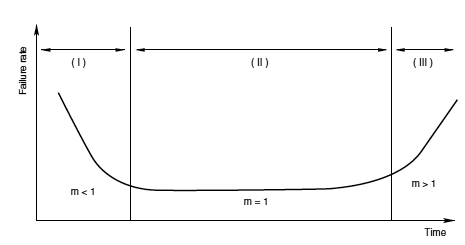
3. Weibull Analysis
Weibull analysis is often used for classifying a product's failure patterns and to determine its lifetime.
Weibull distribution is expressed by the following equation:

m: Figure parameter
α: Measurement parameter
γ: Position parameter
Weibull distribution can be adopted to the actual failure rate distribution if the three variables above are estimated.
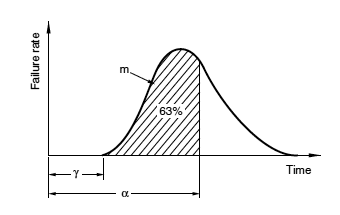
The Weibull probability chart is a simpler alternative of complex calculation formulas. The chart provides the following advantages:
(1) The Weibull distribution has the closest proximity to the actual failure rate distribution.
(2) The Weibull probability chart is easy to use.
(3) Different types of failures can be identified on the chart.
The following describes the correlation with the bathtub curve. The value of the parameter " m " represents the type of the failure.
(1) When m < 1: Initial failures
(2) When m = 1: Accidental failures
(3) When m > 1: Wear-out failures
Automotive Relays Related Information
